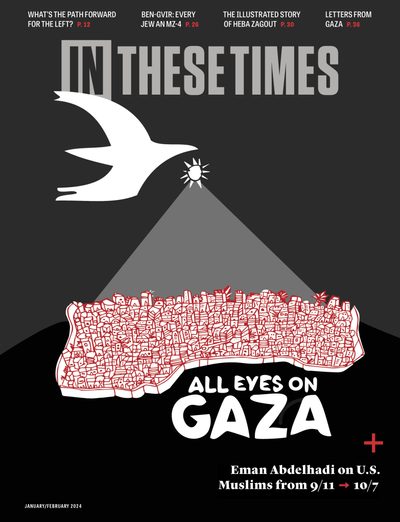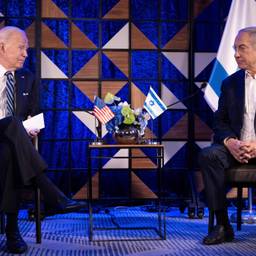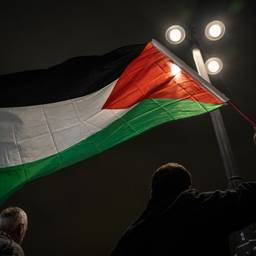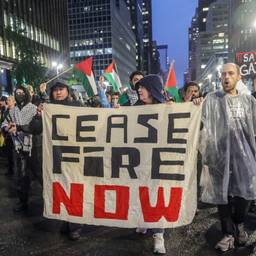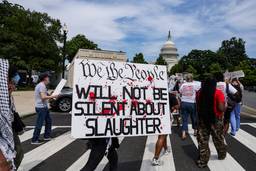The Largest Pro-Palestinian Protest in U.S. History Was "A Turning Point." Now It's Spreading.
“Felt like this was a new wave or a turning point in the struggle for Palestine.”
Henry Hicks IV
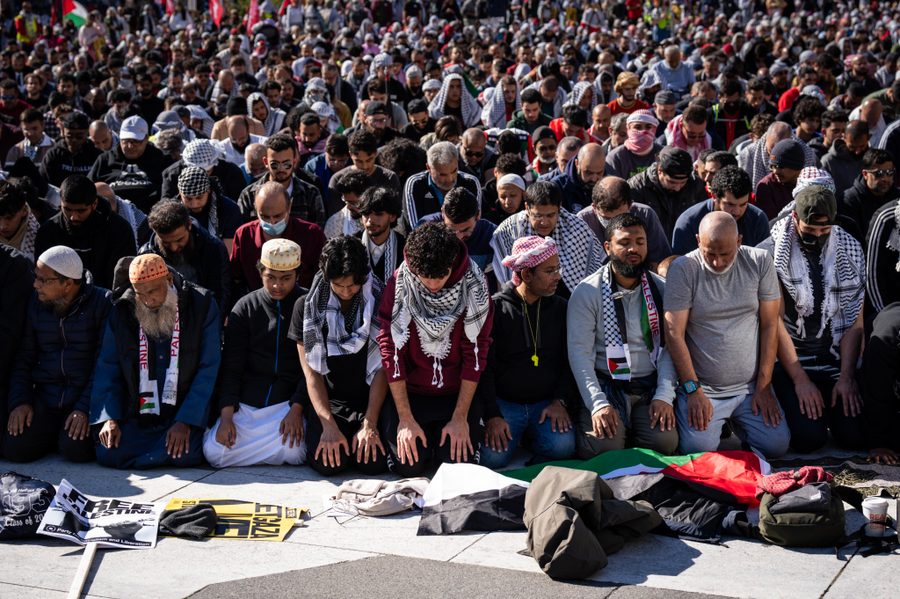
When 20-year-old Hanan flew from Atlanta to Washington, D.C., to join the National March on Washington for Palestine, he expected there to be, perhaps, 25,000 other protesters. But what he encountered at Freedom Plaza on November 4 was a stunning rolling sea of marchers overwhelming the blocked off streets. The march pulled in an estimated 300,000 supporters, making it the largest rally in solidarity with Palestine in U.S. history.
“I wanted to make sure that there’s a cease-fire,” says Hanan (who declined to give his full name due to concerns about harassment). “Every day, I see kids dying on my phone, and I want to do something to [stop] that. I want to make sure that the kids stop dying.”
The march comes after a month of sustained Israeli assault on Gaza, which followed an attack by Hamas on October 7 that killed more than 1,000 people in Israel and saw about 220 people taken hostage. More than 11,000 people in Gaza have been killed by the Israeli military in this act of collective punishment, including more than 4,000 children and at least 155 others in the West Bank.
Comparable to the size of Las Vegas (but with three times the population) Gaza has faced nearly 1,000 Israeli Defense Forces bombs per day since the conflict began, often targeting refugee camps, hospitals, schools and mosques. Some 1.4 million Palestinians have been displaced while the Israeli government has largely blocked the flow of electricity, water, food and fuel into Gaza. The United Nations Special Rapporteur on Palestine, as well as a former director for the United Nations New York office for the High Commissioner for Human Rights, have referred to the ongoing assault as an ethnic-cleansing event. Despite this, as well as amidst growing support both domestically and globally for a cease-fire, President Joe Biden and Congress have continued to support the effort, claiming an Israeli “right to defense,” advocating for flashpoint humanitarian pauses and advancing legislation to send funding and weaponry to aid in Israel’s military.
The energy at the historic march was pointedly enraged, rather than solemn, however. It included a spirited rally, the mass of protesters charging through the streets of the nation’s capital, and remarks from 35 speakers who called out to the vast sea of supporters from a large stage just a few blocks away from the White House.
“Our liberation projects will continue to overwhelmingly resource power, freedom and dignity […] to all of us and open new paths to our liberation, decolonization, return,” says Tara Alamani, an organizer with the Palestinian Feminist Collective, who commands the audience with an unshakable resolve in her voice. “Liberation! Decolonization! Return!”
The electric crowd of marchers — students, artists, faith leaders, parents and organizers, among many others — echoed her calls back to her, chanting in firm unison with one another: “Liberation! Decolonization! Return!”
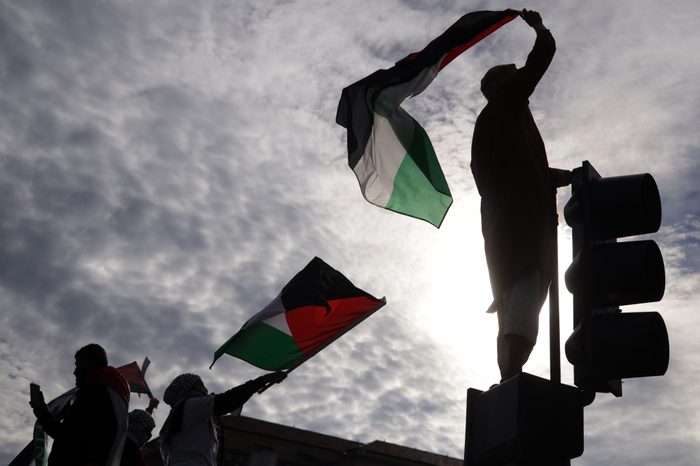

Yara Shoufani, 30, and a member of the Palestinian Youth Movement (PYM), worked as one of the many organizers who shepherded the National March on Washington for Palestine to fruition. PYM, which has 14 chapters spread throughout North America and Europe, began staging local actions following the onset of the Israeli government’s violent and indiscriminate campaign in Gaza. But they also quickly saw the need — and opportunity — to scale up to an unprecedented level.
“As we started to see the genocide unfold on our people in Gaza, there was an immediate sense that we need to do something,” says Shoufani. “We could not continue to do what we’d always been doing. We needed to go further. We needed to take things to the next step. … The amount of energy and persistence and determination to stop the genocide was so clear to us. So, we convened with other like-minded organizations and made the decision to start to organize a march on D.C.”
PYM was joined by nine other groups that formed the initial coalition that came together to sponsor the march. That coalition was soon joined by almost 250 organizations and groups who endorsed the effort, including ones with a national reach and campus-level organizations.
“[It] felt like this was a new wave or a turning point in the struggle for Palestine,” says Layan Fuleihan, 32, education director at The People’s Forum, one of the initial cosponsoring organizations. “To have a moment where we could come in full force to Washington, D.C., and make [our] demands heard, was really important to so many people.”
There were three demands put forward by march organizers: end unconditional U.S. aid to Israel, an immediate cease-fire and to lift the ongoing siege of Gaza.
“We don’t want to just hold the line, because that line is not at all far enough,” says Fuleihan. “Our goal — if we’re in solidarity with Palestine — is to end the occupation. To finish with apartheid. To end the 75 years of brutal [treatment]. It’s been an ongoing genocide of the Palestinian people and an ongoing ethnic cleansing. This is the moment where we can’t limit ourselves.”
Shoufani agrees: “In this particular moment, we are definitely seeing a level of mass movement that feels really historic — and is building on the over 75 years long of people’s struggle. … People [at the November 4 protest] just kept saying that they felt like everything was changing, that nothing would ever be the same after this march.”
Ileana Roque Gonzales, 45, traveled to D.C. from Immokale, Fla. She caught a flight, arrived in the morning and planned to return home that evening. For her and so many others, Palestinian liberation has been an urgent issue for decades, and one with renewed urgency in this current moment.
“It’s appalling that we’re still marching against genocide. … This has been going on for so long,” Roque Gonzales says. “[But] this horrible event that happened a month ago, [the Hamas attack on October 7 and Israel’s response], it brought our attention back to Palestine and to the area. … This time feels a little different.”
In addition to the hundreds of organizations that endorsed the march, the action was attended by a wide array of supporters, all coming from diverse geographic, religious and professional backgrounds. Blocs of LGBTQ attendees marched with pride and in solidarity. Entire families rallied together, offering bullhorns to young children to lead in chants such as “Hey hey, ho ho, the occupation has got to go!” Joining them, notably, was an organized cohort that marched as Biden administration staffers. While marching in the crowd, they held spray-painted signs: “BIDEN. YOUR STAFF DEMANDS A CEASEFIRE.”
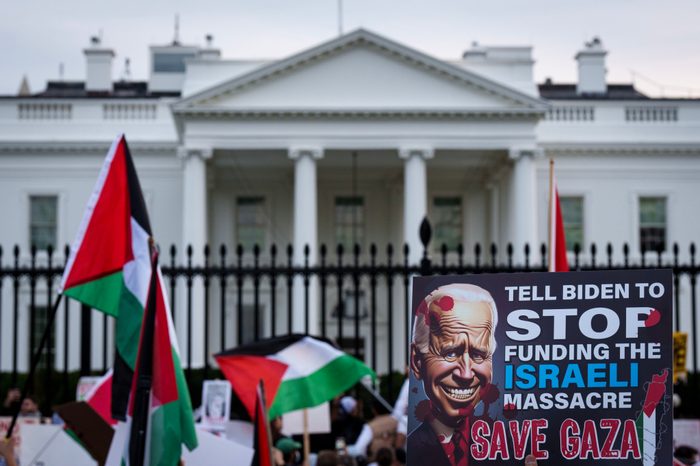
An administration staffer who was part of the demonstration spoke to In These Times on condition of anonymity, saying that they, along with numerous other colleagues throughout the administration, “feel so disappointed and defeated by the administration’s response to [the crisis in Gaza] and hope that pressure from both the inside and outside can help change that.”
The group of staffers, including congressional staff who would later host a walkout and vigil on the steps of the U.S. Capitol days later, self-organized in the days leading up to the march.
“It seemed clear that so many of us were feeling the same and willing to do something about it. … I want people to know that there are folks on the inside who stand with them; and from many people’s reaction to our group during the march itself, that seemed to have a real impact,” they say.
Jewish activists were also a part of the broad coalition that marched on November 4, rallying under the banners of “Not in our name” and “Never again is now” in an effort to upend the false narrative that Jewish safety and Palestinian liberation are in opposition to one another.
Herb Meisner, 26, a Jewish organizer with the D.C. chapter of IfNotNow, attended the march wearing a yarmulke and tallit. He says that it was important for him to attend and for him to do so while proudly representing his Jewish identity.
“I’m a teacher at a local synagogue here, New Synagogue Project. I came [to the protest] from being an educator [at classes] today, grabbing a coffee and then coming to this protest,” he says. “This is the most Jewish thing I can do. … I refuse to be quiet when a government, including America, is using my name to do war crimes and atrocities.”
While many of the protesters were local to D.C. or the surrounding DMV area, so many others, like Hanan and Roque Gonzalez, traveled by plane, bus or train to get there.
“We had 36 buses from New York City. The buses kept selling out,” recounts Fuleihan. “It’s a lot harder to get a bus from Florida than it is to get one from New York, but it still happened. … There were buses from Houston, even. People were on the bus all day and all night to get there.”
Shoufani says that the march “was so critical because it shows us that at the height of all of the repression, all of the surveillance, all of the dehumanization, people are choosing to challenge the fear that they might be feeling, get on a bus and overcome all the barriers in order to take part in a march.”
“We are stronger in numbers. We are stronger when we choose to challenge that fear. … It really felt like a community coming together in order to do something that was historic, and to stand on the right side of history,” Shoufani says.
Fuleihan adds that protesters coming to the march “[sent] pictures of planes full of people wearing keffiyehs. In the United States, going in the airport with one of these is … there was a time where you didn’t do that. And now we’re talking about people flying to D.C. together to express this. It’s really impactful.”
Organizers were confident that the spirited energy generated on November 4 will flow outward into local communities, which will elevate the profile of the Palestinian’s struggle, strengthen local organizing efforts and hopefully result in a sustained movement that will continue raising the temperature.
“We can’t all come to DC every single weekend, of course. But that doesn’t mean that we’re not out [organizing]. And that doesn’t mean that we can’t have an impact,” continues Fuleihan. “In fact, the more we call for a diversity of tactics, the more we can really grow the movement. Everyone, in their own context, suddenly can be someone who’s educating about the Palestinian condition and the Palestinian cause … who is helping shift consciousness in their own community — and that’s really going to make a huge impact.”
Many of the protesters who joined the historic march plan to do just that.

“[I’ll be] telling my friends, telling my coworkers, raising awareness in my community,” says Hanan. “Telling the people that don’t know about this … and just making them realize what’s happening.”
Roque Gonzales plans to “[take] more time and more energy to speak to family members that might not know all the nuances around what’s happening, and what has been happening for a long time. That is what I’m going to be focusing on — starting with family, starting with friends and going from there.”
Meisner says he’ll be “continuing to shout, continuing to share my voice, continuing protests — civil disobedience, if it needs to be.”
PYM and the People’s Forum, say plans are already in motion to keep the ongoing movement for a cease-fire in Gaza and for broader liberation for the Palestinian people.
“We’re working toward something that is not just to say that we made history on November 4, but to actually say, ‘Okay, how are we going to build from here? How are we going to build a sustained movement in order to get our demands?’” says Shoufani. “The morning after the march, we didn’t have a cease-fire. Gaza is still under a siege. A blockade which has been going on for [nearly] 17 years now. And the United States is still sending money to Israel for weapons, and weapons to Israel. Our job is not done, and we know that our job is not done.”
One next step the movement has undertaken includes staging the Global Shutdown for Palestine, an action organized by PYM, National Students for Justice in Palestine, ANSWER Coalition, The People’s Forum and International Peoples’ Assembly. The Global Shutdown, piloted on November 9, calls for mass disruption across all industries — education, media, manufacturing and more.
“We’re calling on mass shutdown of all industries — refusing to continue with business as usual while genocide is unraveling before our eyes,” says Shoufani. In its first wave, the action involved the mass mobilization of students and media workers. Distributed around the country — and the globe — more than 500 actions were held on November 9 to support a cease-fire and a liberated Palestine. Students walked out of classes in Oregon, Arizona, California and several other states. In New York City, protesters and writers occupied the offices of The New York Times, brandishing mock newspapers referring to the historic death toll of journalists caused by the violence overseas and demanding that the editorial board call for a cease-fire.
“[The November 9 shutdown] won’t be the last,” says Fuleihan. “No matter what, people are going to be on the street every day until the demands are met. People are not going to accept anything less at this point.” Polling shows that 66% of American voters support a cease-fire and de-escalation in Gaza.
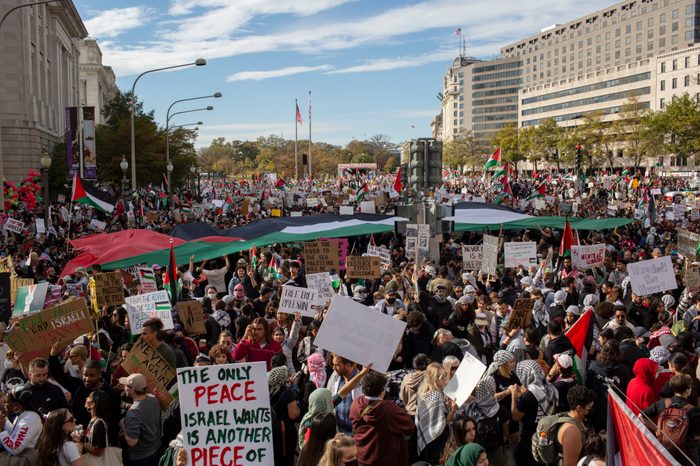
And, as stated by Feileihan, the people’s energy has persisted. On Sunday, November 12, over 10,000 protesters filled the streets in Austin, Texas, to call for a cease-fire — again, pulling in the attention of national media and signaling the broad unity among Americans on this issue.
Fuleihan says, “Biden, look at your own streets.”
“I believe the culture of deference that exists within the administration and much of D.C. is not healthy,” says a Biden Administration staffer. “With this issue and many others, it only further entrenches the disconnect between what political leadership does and what the American people want.”
“The Palestinian cause is gaining more and more support,” says Hanan, hearing the crowd’s cries for a free Palestine reach their peak as the trod begins its push down Pennsylvania Avenue toward the White House. “This support is grassroots, and it’s going to eventually get to the top. Our politicians will see this. And it will make a difference.”
Henry Hicks IV is a Washington D.C.-based writer and organizer. Originally from Nashville, Tenn., he is a graduate of Oberlin College and is a Harry S. Truman scholar.
